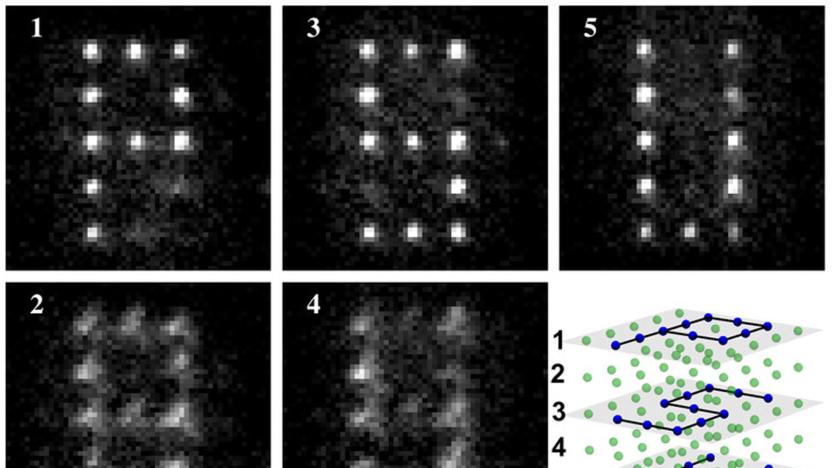pennstate
Latest

Bacteria could lead to cleaner methane power
Methane as a greenhouse gas isn't all that eco-friendly when used for power, but scientists might have a way to keep the damage to a minimum. Penn State researchers have crafted microbial fuel cells that can convert methane into electricity right at the well, without leaking loads of gas into the atmosphere by sending it through pipes. The team created a cocktail of bacteria (including a synthetic microbe you can't normally grow) that produces the necessary materials to grab and transport electrons from the methane. Not only is this a relatively clean process, the bacteria can run on waste products -- it might clean up the site as it generates power.

Scientists make battery that runs on air and carbon dioxide
Researchers at Penn State University have potentially come up with yet another way we could create energy from all that nasty carbon dioxide we pump into the atmosphere. They've developed an inexpensive flow cell battery that uses mostly water solutions containing either dissolved CO2 or dissolved normal air -- the technical name for the dissolving process is called sparging, just FYI. Because the liquids contain different concentrations of CO2, they have different pH levels, and it's this imbalance that generates electricity.

Big Ten Network adds 'League of Legends' to its tournament lineup
The Big Ten Network announced on Thursday that it's adding a less conventional sport to its conference title coverage. Now, in addition to everything from baseball and basketball to football and field hockey, subscribers will be able to see their favorite schools compete against one another in League of Legends. Yeah, the video game.

Scientists recreate the outer layer of the heart with stem cells
While organ transplants saw a 20 percent increase in the past five years, a lot of people in the recipient list still won't get one. That's why various scientists across the globe are trying to recreate organs in the lab. One particular group from Penn State, for instance, chose to focus on the heart, and they recently found a way to turn human stem cells into epicardium cells, which cover the surface of the organ.

Climate change could explain Mars' imposing topography
Mars has lots of water, but future astronauts won't exactly be able to scoop it into bottles -- it's generally trapped in ice deposits below the surface. Scientists from Penn State think climate change lasting millions of years once warmed it enough to let the water flow free on the surface, however. That might have created large lakes in Gale Crater (above) and etched out channels and other water-based features on the Red Planet.

Squid protein makes textiles self-healing
You might be able to repair your ripped jeans one day just be adding water, thanks to a breakthrough from Penn State researchers. Based on its earlier research on self-healing plastics, the team turned squid teeth proteins (yep) into a liquid form using yeast and bacteria, then used it to coat cotton, wool and other fabrics. If the material is torn, you just need to put the edges together, apply warm water and it magically "heals," as flexible and strong as before -- even after being laundered.

Lasers and microwaves lead to better quantum computing circuits
If you're going to craft a quantum computer, you need to corral lots of quantum bits (qubits) to perform calculations... and Penn State researchers have found a way to make that happen. They've developed a technique that relies on lasers and microwaves to steer a tightly packed, 3D grid of atoms that serve as qubits. When you want to change the state of these atoms, you hit them with crossed laser beams and then bathe them in uniform microwaves. In a test, scientists had enough control to spell out "PSU" across a three-layer array of 125 atoms.

Genetically modified mushrooms cleared by the USDA
While the ethical debate rages on about genetically modified human embryos, the United States Department of Agriculture has cleared its first CRISPR-modified organism. CRISPR, in case you've forgotten, is an editing technique that can alter the genome of almost any organism pretty easily. Penn State University's agriculture department used the method on white button mushrooms to include an anti-browning phenotype that reduced the polyphenol oxidase enzyme (turns produce brown when exposed to air) down to about 70 percent effectiveness. Popular Science notes that because CRISPR doesn't use bacteria or viruses to affect the DNA like previous methods have, these 'shrooms aren't considered "plant pests."

NASA is building a new exoplanet-hunting tool
NASA and the National Science Foundation (NSF) are done forming the special team of astronomers to build their new, powerful exoplanet hunter. The scientists were selected after holding a national competition and will be led by Penn State University assistant professor Suvrath Mahadevan. They'll now spend the next three years building the $10 million instrument called NN-EXPLORE Exoplanet Investigations with Doppler Spectroscopy (NEID) for the joint project. Once it's finished, the instrument will be installed on the 3.5-meter WIYN observatory (pictured above) at the Kitt Peak National Observatory in Arizona.

Here's how 'flawless' materials break on a nanoscopic scale
Have you ever wondered why a supposedly defect-free material ends up cracking? University of Pennsylvania researchers have an answer. They've studied supposedly flawless materials (in this case, palladium nanowires) to see how they break on a nanoscopic level. As it turns out, these failures usually come down to atoms floating around when their bonds break, usually with little change in temperature. It's seemingly random, too, since the bonds vary widely from atom to atom. The scientists hope that identifying these weak points will help design devices that hold up under strain, even at the smallest possible level. Don't be surprised if you're one day using gadgets that are much more reliable, even at the smallest possible levels. [Image credit: VladKol/Shutterstock]

DARPA to develop best practices for 3D printing
Just as steel's physical properties change depending on how it's produced, so too do 3D printed materials. However, unlike steel, we don't yet fully understand how different these newfound techniques affect the resulting printed item. Sometimes a printed item -- even if it's made from something common like aluminum -- ends up having a very different microstructure had it been created with traditional, subtractive methods. You can see an example of that below. Heck, even using the same material on different printer models can result items with wildly divergent properties. But DARPA is looking to change that. The DoD's advanced research agency announced Friday that it is launching an Open Manufacturing program to create comprehensive reference documentation for 3D printing and usher in an era of productive predictability.

Penn State says it was the victim of a China-based cyberattack
Cyberattacks are in the news seemingly every day, and today's announcement comes from a university here in the States. Penn State announced that its College of Engineering was targeted in a pair of "sophisticated cyberattacks," and investigators discovered that one of the breaches originated in China. The FBI notified the university of the attack back in November, but security experts investigating the matter determined that the hackers could've first accessed the system as early as 2012 using "advanced malware." The good news is no sensitive personal info (social security numbers, etc.) or research data was taken, as only usernames and passwords were compromised. Penn State took the College of Engineering's systems off the internet while security measures are bolstered, remedying a breach that's said to affect 18,000 people. [Image credit: Moment Editorial/Getty Images]

Fraunhofer develops extra-small 1Gbps infrared transceiver, recalls our PDA glory days
Our 1997-era selves would die with envy right about now. Fraunhofer has developed a new generation of infrared transceiver that can transfer data at 1Gbps, or well above anything that our vintage PDAs could manage. While the speed is nothing new by itself -- we saw such rates in 2010 Penn State experiments -- it's the size that makes the difference. The laser diode and processing are efficient enough to fit into a small module whose transceiver is as large as a "child's fingernail." In theory, the advancement makes infrared once more viable for mobile device syncing, with room to grow: even the current technology can scale to 3Gbps, lead researcher Frank Deicke says, and it might jump to 10Gbps with enough work. Along with the usual refinements, most of the challenge in getting production hardware rests in persuading the Infrared Data Association to adopt Deicke's work as a standard. If that ever comes to pass, we may just break out our PalmPilot's infrared adapter to try it for old time's sake.

New quantum tunneling transistors to make PCs less power-hungry
Yes, that awesome new 8-core chip in your PC is the fastest thing on the block, but it's got your utility meter spinning accordingly. Fortunately, researchers from Penn State have come up with a new high performance transistor that may turn future chips from power hogs into current-sipping silicon. The group, in cooperation with semiconductor manufacturer IQE, has created a high-performance transistor capable of significantly reducing power demand whether it's idle or switching. Doctoral candidate Dheeraj Mohata's the one who made it happen by inventing an alternative to traditional MOSFET (metal-oxide semiconductor field-effect transistors) technology capable of turning on and off using far less power. Mohata's method uses a tunneling field effect transistor crafted from dissimilar semiconductor materials to provide instant on-off capability at 300 millivolts -- compared to MOSFET's one volt requirement -- to provide a power savings of 70 percent. You can dig deeper into the technical transistor details at the source, but all you really need to know is that the ladies love a PC with paltry power consumption.

Microbial fuel cell produces hydrogen from wastewater without wasting energy
Back in 2005, Bruce Logan and his team of Penn State researchers developed a microbial fuel cell capable of converting poop into power. Now, Logan has refined his system to the point where it can produce hydrogen from wastewater or biodegradable organic materials without using a drop of grid electricity, and without emitting even a hint of carbon dioxide. His approach, outlined in the September 19th issue of the Proceedings of the National Academy of Sciences, involves something known as reverse-electrodialysis (RED) -- a process that harvests energy from the ionic discrepancy between fresh and salt water. Logan's bacterial hydrolysis cell (pictured left) features a so-called RED stack that's comprised of alternating positive and negative ion exchange membranes, which it uses to split water molecules into hydrogen and oxygen. Normally, this process would involve about 25 pairs of membranes, but by using RED technology in conjunction with electricity-producing exoelectrogenic bacteria, Penn State's team was able to extract hydrogen with just five membrane pairs. All told, Logan's cells proved to be about 58 to 64 percent energy efficient, while producing between 0.8 to 1.6 cubic meters of hydrogen for every cubic meter of liquid that passed through the system. The researchers' results show that only one percent of that energy was used to pump water through the cells, which are completely carbon neutral, as well. According to Logan, this breakthrough demonstrates that "pure hydrogen gas can efficiently be produced from virtually limitless supplies of seawater and river water and biodegradable organic matter." Somewhere, the US Navy is taking scrupulous notes. Full PR after the break. [Image courtesy of Penn State / Bruce Logan]

Scientists develop blood swimming 'microspiders' to heal injuries, deliver drugs
Scientists at Penn State would like to release tiny spiders into your blood -- no, it's not the premise for a new horror movie, but rather, it's a medical breakthrough. The spider-like machines are less than a micrometer wide (just so you know, a red blood cell is around six to ten micrometers), and are designed to travel through veins delivering drugs and a little TLC to damaged areas -- not a totally new concept, per se, but even minor advancements can open up all sorts of new doors for troubled patients. Made of half gold, half silica, these microspiders are self-propelled by a molecule called the Grubbs catalyst, which scientists can control directionally using chemicals. Although still in the preliminary phases, lead researcher Ayusman Sen hopes to one day attach the creepy crawlers to nanobots, which could maneuver through the body to detect tumors, helping the immune system and scrubbing vessels clean of plaque. Not like that's doing anything to diffuse your arachnophobia, but hey...

Penn State's optical wireless tech does gigabit, bounces off walls
We love our WiFi, but it's far from perfect. Speed depends greatly on conditions, magnetic waves don't always play nicely with sensitive equipment, and the ability for someone to drive by and steal your precious infos is always disconcerting. Researchers at Penn State have what they believe is a better solution: light. The team uses laser diodes to convert data signals to light, then photo diodes on the other end to convert it back to data, a system that (unlike others we've seen) doesn't require direct line of sight as the light will bounce off of walls -- except those painted black (sorry goths). Data access could easily be constrained within a single room or, if it was needed elsewhere, wired relays could bring it through walls. Speeds at this point are already at the 1Gb/sec range, twice what Siemens was able to manage a few weeks ago, and enough for wireless transmission of high-definition video. Someday your Wiimote and remote might not be the only things beaming back at ya in the living room.

Penn State busts out 100mm graphene wafers, halcyonic dream inches closer to reality
Yes, we've been marching on this road to graphene-based superconductive electronics for a long, long time. But in the space of one week, we've now seen two significant advancements pop up that rekindle our hope for an ultrafast tomorrow. Hot on the heels of IBM's recent bandgap achievement comes Penn State University with a 100mm wafer of pure graphene gorgeousness. Built using silicon sublimation -- a process of essentially evaporating the silicon away from the carbon layer -- these are the biggest graphene wafers yet, and field effect transistors are being built atop them now to start performance testing early this year. Naturally, nobody's sitting on this laurel just yet, with further plans afoot to expand beyond 200mm wafers in order to integrate fully into the semiconductor industry, whose current standard wafer size is around 300mm in diameter. On we go then.

New solar cell cuts out the middle man, harvests hydrogen from water
Some Penn State researchers are taking a cue from nature and have built the first solar cell that can effectively split water to harvest the hydrogen. While the technology and efficiency of electricity-gathering solar cells has been humming on nicely, cells that can pull hydrogen out of water directly (instead of using solar-harvested electricity to do it) have found that the catalysts conducive to separating hydrogen and oxygen are usually pretty good at putting the two gases right back together again. The folks at Penn State have now developed a process that more closely mimics the photosynthesis process in plants, and while we won't pretend to understand all the nitty gritty of dye usage and other such nonsense, we do know that such a system could eventually attain 15% or so efficiency, providing a nice and clean way to gather power for that fuel cell car of the future.[Image courtesy of MTU.edu]

Penn State goes Big Brother with new high-security testing room
Our attempts to cheat in college pretty much boiled down to a smeary mess of indecipherable acronyms written on our palms, but apparently the kids at Penn State have moved on from iPods and calculators, because the school has resorted to building a high-tech cheat-proof exam facility to cut down on the fakers. Students first enter through a security gate which displays ID photos to proctors on monitors as kids swipe their IDs before sitting down at individual cubes outfitted with network-disabled PCs to take their tests. Proctors are given strict lists of what's allowed and what's not -- everything from textbooks to pencils can be outlawed -- and continually monitor the room with a bank of ceiling-mounted video cameras as well as random spot-checks. We're not certain why Penn State wants test-taking to be even more nerve-wracking than it already is, but something tells us profs who give 24-hour take home exams are going to be mighty popular from now on.[Via Switched]











